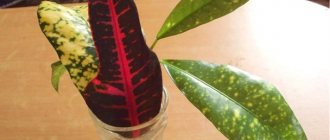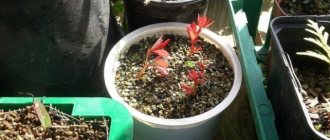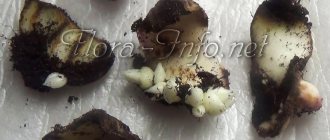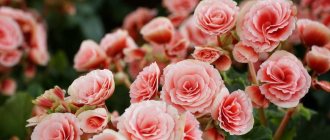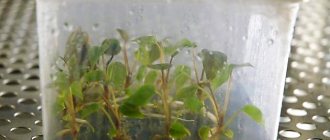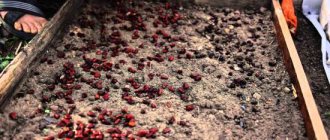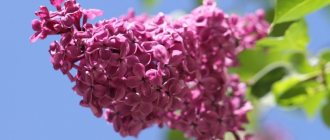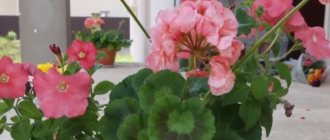When is the best time to perform the procedure?
The choice of time of year for propagating royal begonia depends on the intended method:
- Cuttings.
The most suitable period for cuttings is from August to September. It is during this period that the plant is pruned after flowering, and the cut shoots can be used as planting material. - Dividing the bush.
For propagation of royal pelargonium by dividing the bush, the recommended time is late spring - early summer: it is during this period that the plant is in the active growing season, so it can easily withstand any manipulation.The division of the bush occurs during transplantation of the plant if it has grown greatly.
- Seeds.
Sowing of seeds is usually done in March. It is possible earlier, but then the seedlings will need additional lighting with a phytolamp.
Vaccinations for longer flowering period
The flowering of the plant is much shorter than that of other species. Finding out why the royal geranium does not bloom like other species is difficult; it all depends on the nature of the creature. The bush is also not that tall. By grafting geranium species with different germination rates, the growth patterns also change. It is for this reason that by grafting medium-sized varieties of fruit-bearing species onto dwarf rootstocks, it is possible to achieve the appearance of fruits earlier than on their own roots and to enhance reproduction.
Unpretentious indoor flower
How to propagate royal geranium correctly without damaging the plant and at the same time graft it onto another species? Just! The grafted branches are generally smaller in length and larger in volume. They have a well-groomed bush on their own. These properties are necessary to graft pelargonium into a high zonal plant. The zonal one should lose the top of its head no more than 60 cm in height.
The rest of the standard should already be mature. The grafted plant must be at least 10 cm in height. Using the sharpest possible knife, trim the lower limb of the geranium in the shape of a wedge. The two branches should have approximately the same diameter. The branches of the resulting plant are also suitable for propagating royal geraniums by cuttings.
The zonal bole is cut at the very top to a depth of 2 cm. The shape of the cut is V-shaped. Into this cut you need to insert a grafted, pointed, grafted branch, which is aligned along the edges of the split. The joint is wrapped with grafting film. You need to start winding from the top, moving down. The overlap is small; you need to grab a little of both the bole and the scion. By the way, it is better to propagate with the help of grafted limbs due to their greater survivability.
How to properly maintain exquisite pelargonium?
The growth of the bush can vary in intensity, so it is advisable to provide support. The stem must be cleaned of newly appearing buds. If the plant immediately produces buds, they are pinched off. It blooms and the forces needed for fusion are gone.
Preparing the mother plant
Each method of reproduction requires certain manipulations with the maternal specimen:
- Before cuttings, the plant undergoes seasonal pruning.
- When dividing the bush, pelargonium should be watered abundantly beforehand to reduce the risk of injury to the roots.
- When collecting seeds, there should be no flowers left on the plant bush, except for the selected ones, from which the seed material will be collected.
What is the best time to do this?
Before propagating geranium, you need to determine the most favorable period for this. It is worth taking into account the natural cycle of culture. Although geraniums can bloom throughout the year, early spring is considered the ideal time for cuttings. The procedure should be carried out at the end of February or mid-March.
Geranium Rozanne
Of course, it is permissible to grow the plant in autumn and winter. However, in this case, rooting will take much longer. The sprouts will need artificial lighting. Dilution is recommended to be carried out with a minimum of 17 hours of daylight.
Important! In summer, the breeding procedure can also cause certain difficulties. Hot weather negatively affects the development of immature shoots.
How to propagate?
Cuttings
Cuttings are an artificial method of vegetative propagation of plants, in which parts separated from the mother plant - cuttings - are used. A cutting is a specially separated part of a plant (shoot).
Tops obtained by trimming faded pelargonium are used as cuttings. An important condition: the cutting must have 2 - 3 internodes, its total length - from 8 to 20 cm.
It is not recommended that the selected shoot contain more than 5–6 leaves, as they will take away some of the nutrients and moisture, which will negatively affect the rooting process. It is better to completely remove the lower leaves from the cuttings, and cut the upper ones in half.
Reference! A node is where leaves grow, and an internode is the distance between nodes.
The shoot is cut from the mother plant with a sharp knife just below the node and at a slight angle. The cut can be treated with charcoal. Be sure to dry the cuttings slightly before rooting, that is, leave them indoors or outdoors for 2 to 8 hours (but not in direct sunlight).
Royal pelargonium must be rooted directly into the ground. If the cutting is immersed in a container of water, then with a 100% guarantee it will rot and, accordingly, die.
Before planting the cutting in the ground, you can treat its lower tip (it is cut at an angle) with any root formation stimulator (Kornevin, Heteroauxin, Epin-Extra, etc.).
We invite you to watch a video on how to propagate royal pelargonium from cuttings:
Rooting cuttings
The cutting is buried 2 - 2.5 cm into the moistened substrate, which is pressed tightly around the plant to avoid the presence of air bubbles that negatively affect the process of root formation.
Pelargonium does not like excess moisture, so it is not advisable to install a “greenhouse”: just place the container in a warm (+20C – +25C), moderately lit place, but without direct sunlight on the future plant. Shelter (a plastic bag or glass jar) can be used only as a last resort: if the leaves have turned yellow or withered.
The shoots should be watered systematically, but moderately. Spraying should not be done. After approximately 1 - 2 months, the cuttings will take root. A sign of this is the appearance of young leaves and the relative growth of the shoot.
After planting the plant in a permanent pot, you need to pinch: the first pinch is above the 3rd pair of leaves, and new shoots are also pinched. Pinching is done in order to stimulate branching of the plant in order to form a bush of the required shape.
From the video you will learn how to properly root cuttings of royal pelargonium:
Dividing the bush
Royal pelargonium is propagated by dividing the bush during plant transplantation.
- After removing the plant from the old pot, you must carefully examine its root system; all rotten or dried elements must be removed.
- Next, you should separate a part of the pelargonium with a sufficient number of shoots and viable roots, place it in a pot in the center, previously prepared for planting (drainage, substrate), fill the resulting voids with soil and press it around the plant with your hands.
- After planting, the plant should be watered quite abundantly, and then moderately, otherwise the root system or stems may rot.
Seeds
When propagated by seeds, the characteristics of the parent plant may not be preserved.
- Royal pelargonium seeds can be collected with your own hands, or can be purchased at any specialty store. But in any case, they are processed: they are soaked in a weak solution of potassium permanganate for 4 hours, and then ground between sheets of sandpaper, since their shell is very hard.
- Loose soil (peat and sand) with humus is poured into a shallow container; seeds are placed on its moistened surface, which are sprinkled with a thin layer of substrate.
- The container is placed in a “greenhouse” (a bag or larger container with a tight-fitting lid). The first shoots will appear in 2 - 3 weeks.
- The soil surface should be systematically irrigated and the seedlings should be ventilated to prevent them from rotting.
Propagation of royal pelargonium. Propagation of royal geranium
Royal geraniums love propagation by cuttings.
Cuttings of royal pelargonium is the most popular and easiest way. Remember that rooting in water is most often unsuccessful, the cutting rots and does not take root, so immediately plant it in the ground. Usually the procedure is carried out from mid-August or early September, but not later. A branch up to 10 cm long is cut from the top. The cutting must have 2-3 nodes. After cutting, leave it for a few hours to dry and then plant it in soil with good drainage.
To protect against diseases, fry the soil in the oven or treat it with a solution of potassium permanganate. After this treatment, the cuttings are planted in the ground no earlier than two days later, so prepare the soil in advance. When rooting is complete, after a few weeks, plant the plant in its permanent pot. To speed up the process, carefully detach the leaves from the branch so that all the plant’s energy goes into the formation of roots.
Propagating plants by seeds is a very labor-intensive process, but this method produces hardy plants with a long flowering period. The seeds are bought in the store - they are oblong and small. They are planted in a deep container.
For soil, it is better to take a mixture of sand and peat with the addition of ash. Planting takes place in mid-February. The seeds are planted half a centimeter into the ground. A month later the first shoots appear. When two leaves are already visible, the sprouts dive into a small pot.
How to root?
If propagation was carried out by cuttings, then the young pelargonium should be transplanted into a separate flower pot using the transfer method, that is, together with a lump of earth, without shaking off the soil from the roots.
Pelargonium shoots grown from seeds are planted in separate pots after the formation of their root system.
The container is first filled with drainage, and then with a loose and light substrate (a mixture of peat and sand or peat and vermiculite in a 1:1 ratio), which is well moistened before planting the shoot. We should not forget that a prerequisite for dishes is the presence of drainage holes at the bottom, necessary for draining excess liquid.
Royal pelargonium requires a slightly cramped pot for lush and abundant flowering. If a flower is planted in a spacious pot, the plant will direct all its efforts to filling the entire volume with roots, and in this case you should forget about flowering (read about why royal pelargonium does not bloom and how to correct the situation here).
Growing
Why many people consider growing a plant difficult is unclear. There is nothing problematic in growing, but to achieve a long flowering period you need to have some skills in looking after the bush. Pelargonium at home (another name) sometimes experiences a lack of lighting. For this reason, the plant tends to stretch, which means it needs to be periodically shortened by pruning. After manipulation, the last layers of soil are replaced with a substrate; replanting is not necessary.
In the summer months, the capricious plant should not be taken out into the garden due to the weak transfer of powerful influxes of street air and rain. It can only be propagated at room temperature. But you can place it in closed rooms (on a terrace, veranda or balcony) without harm to the plant.
One of the constant diseases of the plant is excess water. But you can’t leave it without refilling either, so that it doesn’t dry out. It is good to water with water at room temperature, but the best option would be to pre-boil the water. To prevent the soil from compacting, which the plant does not like, you need to water through the bottom of the vase. The root will absorb the amount of liquid that it now needs and it will be easier to propagate it if the root system has good germination.
Contents of a decorative flower
